Rien Oortgiesen, Jens Tybo Jensen, Infineon Technologies
3.2 Benefits of multilevel class D
The benefits of innovative multilevel class D amplifiers include:
- Smaller solution size and lower cost with less reliance on filters
- Improved efficiency at typical listening levels
- Lower heat generation through greatly reduced power loss
- Enhanced audio quality through more accurate signal reproduction
3.2.1 High efficiency at typical listening levels
Multilevel class D amplifiers are very effective at reducing overall power consumption which is dominated by near-idle power loss, making them a great alternative to traditional class D amplifiers.
When a multilevel amplifier is running in idle operation, each MOSFET in each half-bridge output stage is driven by a 50 percent duty cycle PWM signal.
As Figure 8 demonstrates, the actual output node contains only a direct current (DC) signal (½ PVDD). In a combined BTL configuration, the differential speaker load will only “see” a resulting zero signal in idle.
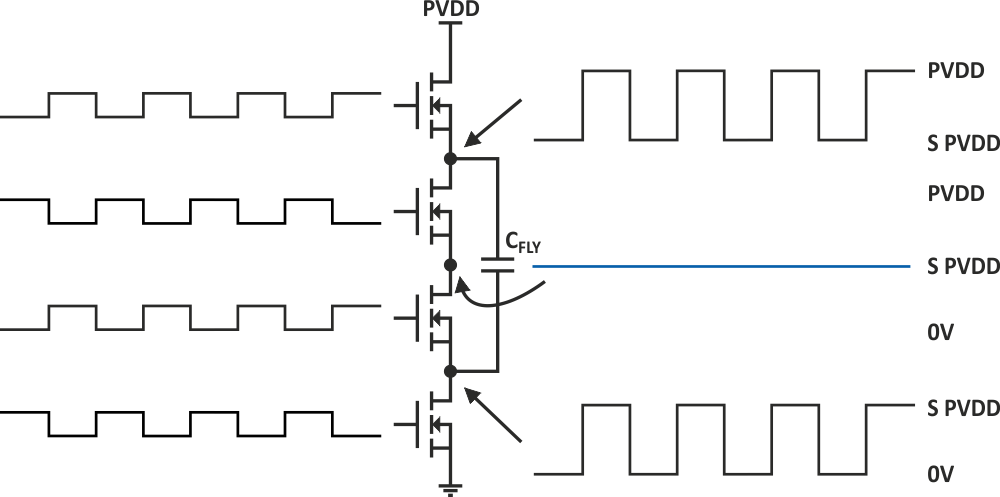 |
||
| Figure 8. | Multilevel output stage in idle operation. | |
For the multilevel audio amplifier system, since no switching activity occurs at the output node when idle, two main mechanisms significantly help reduce the power loss:
- Elimination of idle conduction losses in the power stage, filter and speaker (which are notoriously inefficient load). This applies both for conductive as well as magnetic losses.
- Effective reduction of capacitive switching losses due to the inherent frequency multiplication which is used to scale down the MOSFET switching frequency.
The MERUS™ MA12040 multilevel amplifier as an example, consumes only 250 mW in idle, as seen in Figure 9, which is a power consumption plot. Notice that the near idle power consumption is relatively flat and significantly lower than a conventional class D amplifier all the way up to 2 W output power per channel. Since the overall power consumption is determined by the average power loss and as this is greatly dominated by idle loss when reproducing common audio signals, compared to most conventional class D amplifiers, the multilevel amplifiers demonstrate an overall power efficiency improvement factor of four or higher.
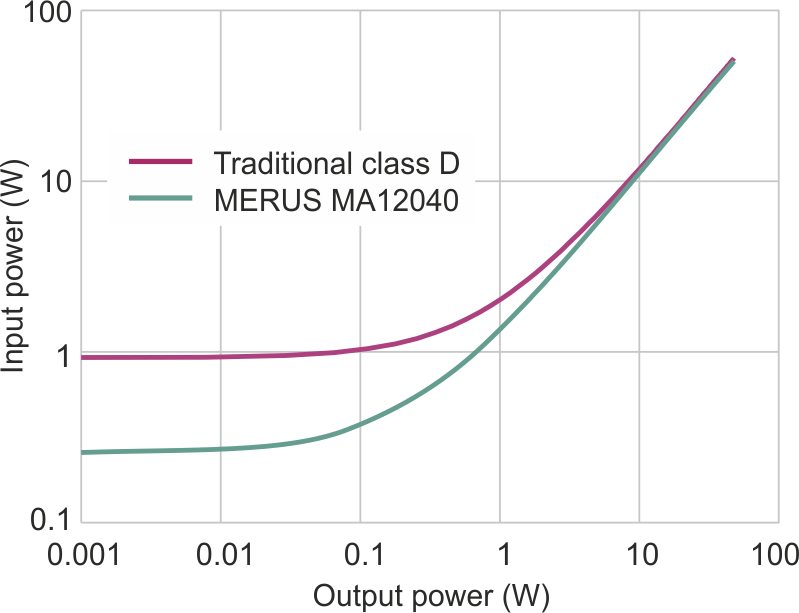 |
||
| Figure 9. | Power consumption of the MERUS™ MA12040 amplifier. | |
The importance of improved power consumption is further emphasized when efficiency is considered in Figure 10. For both Figure 9 and Figure 10, the MERUS™ MA12040 amplifier has a maximum output power of 40 W into a 4 Ω load; in both cases, the amplifier runs on an 18 V power rail.
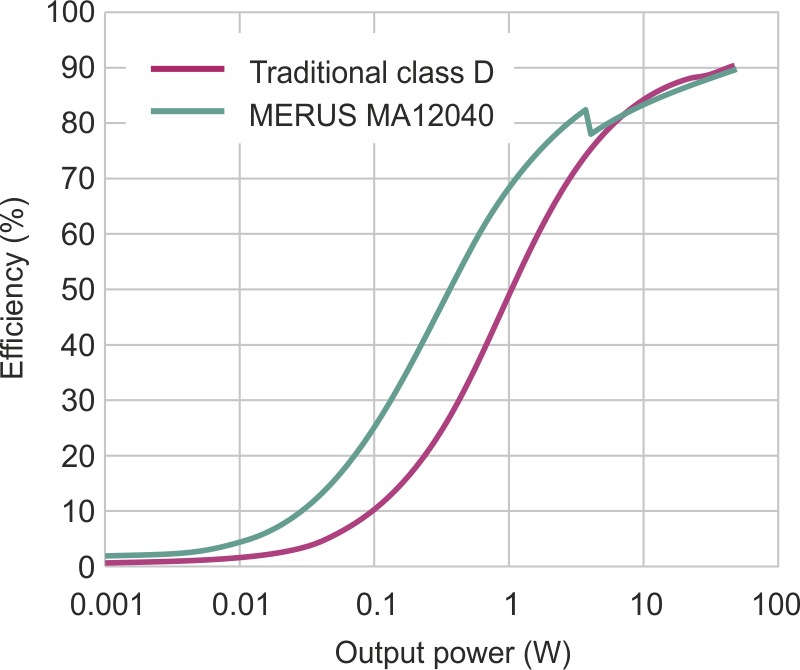 |
||
| Figure 10. | Efficiency of the MERUS™ MA12040 amplifier. | |
Using a digital control interface, various power modes can be accessed by selecting the modulation method and the switching frequency. During amplifier operation, the integrated power management algorithm automatically selects the optimal power mode for a given power level. The seamless transition between power modes ensures that power losses are minimized across the entire output power range while ensuring high audio performance and low EMI.
With low power consumption both for idle operation and for average audio volume levels, portable audio systems can be designed for significantly extended battery life or smaller batteries.
MERUS™ amplifier products allow product designers to develop some of the world’s most efficient portable audio devices, appealing to a vast market of environmentally-conscious consumers who want innovative products.
3.2.2 Size and cost improved
Multilevel modulation schemes have lower EMI signal content than traditional class D amplifiers. EMC is also much improved. Figure 11 shows radiated EMI as measured on the Infineon reference design.
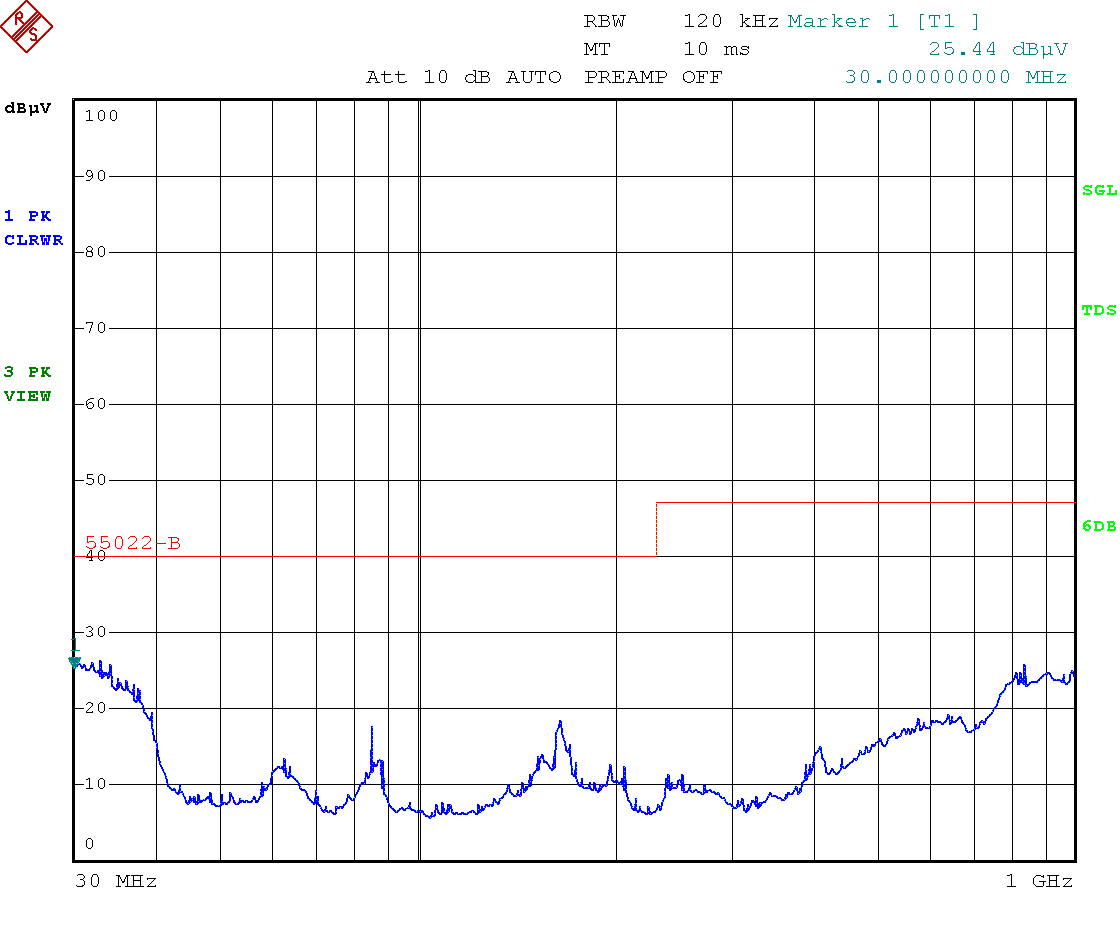 |
||
| Figure 11. | Radiated EMI measured on an Infineon MERUS™ reference design. | |
In the graph can be observed that EN55022-B limits (red line) are easily met with sufficient headroom. EN55022 class B (radio disturbance characteristics limits and methods of measurement) is one of the most stringent standards for consumer products.
Infineon developed a reference design (Figure 12) as a small-sized circuit board used to demonstrate MERUS™ multilevel amplifier devices for ultra-compact and low-power consumer applications. The solution measures 40 mm × 45 mm and yet still achieves output power up to 80 W per channel. Only a small EMI filter is used with an SMD-sized (1210) ferrite bead and an SMD-sized (0402) 1.0 nF capacitor placed at each half-bridge output of the amplifier.
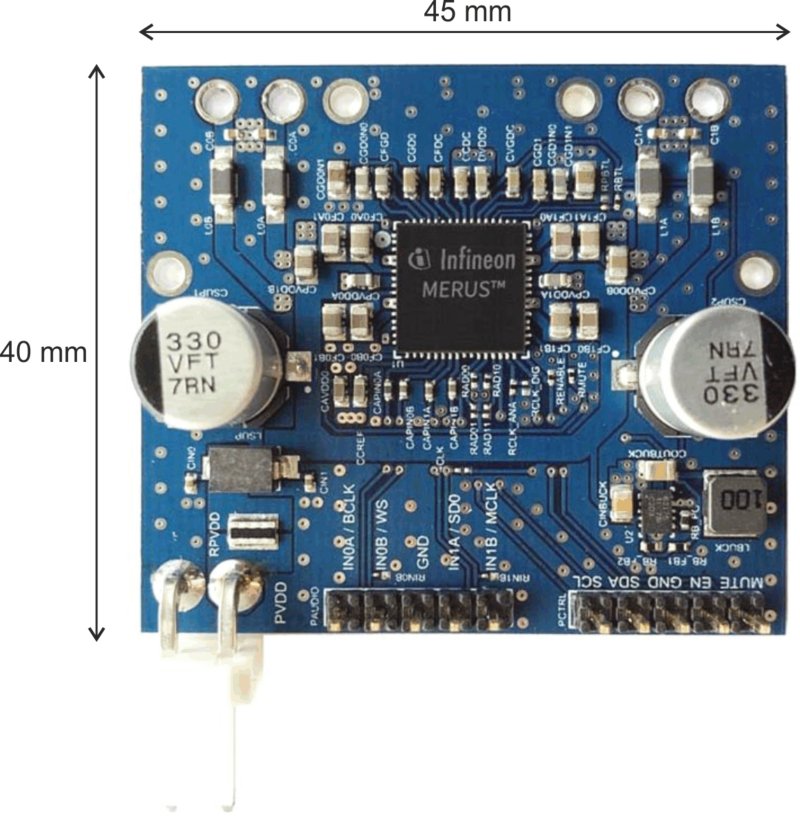 |
||
| Figure 12. | The Infineon reference design with MERUS™ multilevel amplifier. | |
With no need for significant filtering to combat unwanted interference, multilevel amplifiers can drive speakers directly, often without the use of LC and RC filters, even in higher-powered applications, which reduces application costs. If the audio product designer still wishes to use LC filters, filters can be smaller than those used for traditional class D amplifiers.
As illustrated, multilevel amplifiers are ideally suited for ultra-compact solutions and they are easier to integrate into the target application than traditional amplifiers.
3.2.3 Cooler operations
Lower power loss directly translates to less heat generation and cooler operating conditions. In most cases, the amplifier circuit board itself will offer sufficient heatsinking capability, even in relatively high- power applications that would traditionally require a dedicated heatsink.
With generally cooler operation inside the audio application, there is much larger headroom for periods of higher output power, for example during music playback at high volume levels.
Several integrated protection features including on-chip temperature sensors ensure that both the amplifier and speakers are protected from potential damage during various fault events. Cooler operation reduces thermally accelerated aging, which also improves audio application reliability.
3.2.4 Exceptional audio quality
MERUS™ multilevel audio amplifiers incorporate a fourth-order feedback loop to more effectively suppress error sources that might cause audio quality degradation. A multilevel amplifier uses the audio signal to modulate the duty cycle of the PWM signal inside the fourth-order feedback control loop. A fourth-order loop gives much better gain and thus suppression of error sources compared to the more traditional second-order loop. This guarantees very low signal distortion, excellent audio performance and robustness against real-world system imperfections such as a non-ideal power supply rail voltage which produces noise/ripple.
MERUS™ amplifier products, in both analog and digital input versions, fully integrate the feedback loop on-chip. This allows the designer to achieve loop stability and satisfactory performance while minimizing the design-in effort, avoiding a time-consuming selection and optimization procedure for the external loop filter component.
4 Conclusion
This paper explores the benefits of true multilevel class D amplifiers, exemplified by MERUS™ products as the world’s first multilevel audio technology.
Through ultra-high energy efficiency and very compact solutions, true multilevel amplifier technology, which is available both is analog and digital input versions, gives designers of consumer audio applications additional design freedom.
Operating from a fixed power supply voltage, a multilevel amplifier drastically reduces power losses at normal listening levels and in most applications it eliminates the need for LC and RC filters.
Multilevel class D amplifiers excel in applications that require small size, low heat, or low power consumption, including:
- Battery-powered speakers
- Soundbars
- Wireless speakers
- Multi-room audio systems
- Home theatre systems
Multilevel amplifiers enable more powerful sound combined with the lowest power consumption and the smallest footprint for battery and mains powered audio devices alike.
The combination of a multilevel switching topology and a dynamic power management scheme pushes the boundaries of efficiency and the compactness of audio amplifier solutions with exceptional audio quality.